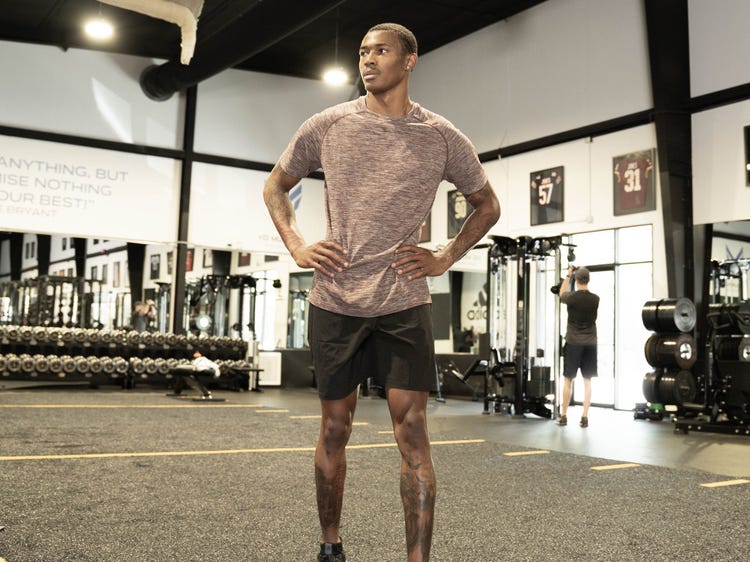
Focusing on your lower body is the best place to start when trying to build glutes. To get the best results from your workouts, increase your intensity. Your glutes will not grow without a significant increase of strength. Avoid leg exercises. They are less effective for the legs. The best way to attain the perfect balance is to do exercises that work your glutes.
Standing leg lifts are a great exercise to strengthen glutes. This exercise requires support from a bench, or any other support. It should be done starting at the hips. Once you are satisfied with your position, lift your left leg up and touch it. You can also alternate moving your weights by going backward and forward. You can even move the weights in the opposite direction. This will give you a toned body and help to develop your glutes.

The glute bridge, another exercise that targets glutes, is also an option. To perform this exercise, you should stand close to a wall. Your "planted” leg should be straight and flat against a wall. The opposite leg should be bent. You can raise your hips by placing your heel in front of the wall. Next, place your heel against the wall and raise your hips. You can make the exercise harder by using weights.
There are many exercises that you can do to increase your glute strength, but the side glute lift is one of the most effective. This exercise requires you to stand straight up and bend your front knee 90 degrees. As you perform the exercise, you'll notice that your body will tilt slightly inward. Your glutes will engage when you push your front leg off the floor. You can add resistance bands to make this exercise even more difficult.
Standing on your hands or knees is another exercise that can help build glutes. Your wrists must be under your shoulders. Your knees need to be slightly bent. Your feet should be below your hips. Do not touch the floor with your feet while doing this exercise. Now bend your knee and press down on your heels. Your bottom should be parallel with the floor.

Starting with your hands on your knees, you can move to the next step. Your wrists should touch your hips, and your knees should touch your shoulders. Next, bend the working knee up to 90 degrees. Perform as many repetitions as you can. Switch sides and alternate legs. You should feel the butt muscle in each of these workouts. It is important to follow a weight training program that will help you reach your goals. But the best way to build glutes is to make the most out of your workouts.
Single-leg Squats are a great exercise to increase your glute strength. Although you are not allowed to train your glutes, this exercise is great for anyone looking to increase their strength. This exercise will help you increase the strength and burn fat in your lower legs. This exercise can help to tone your glutes.
FAQ
What is the problem?
BMI stands For Body Mass Index. This refers to the measurement of body fat using height and weight. BMI is calculated using the following formula:
Add weight in kilograms to height in meters squared.
The result is expressed using a number from 0 through 25. A score greater than 18.5 is considered overweight. A score greater than 23 is considered obese.
A person who weighs 100 kilograms and is 1.75m tall will have an BMI of 22.
What is the best food for me?
There are many factors that influence the best diet, including your gender, age, weight, health condition, lifestyle, and personal preferences. You should also consider how much energy your exercise consumes, whether you like low-calorie or high-calorie foods, and what you enjoy in terms of eating fruits and veggies.
Intermittent fasting is a good option if you're trying to lose weight. Intermittent eating means that you only eat specific meals throughout the day. This is in contrast to three large meals. This approach may prove to be more beneficial than traditional diets that have daily calorie counts.
Research suggests that intermittent fasting may increase insulin sensitivity and lower inflammation. This can result in a reduction in blood sugar levels and a reduced risk of developing diabetes. Research also shows that intermittent fasting may increase fat loss and improve overall physique.
What causes weight loss as we age?
How do I know if my bodyweight changes?
Weight loss occurs when there is less fat than muscle mass. This means that you must consume more calories than you use daily. Low activity levels are the most common cause for weight loss. Others include pregnancy, hormonal imbalances or certain medications. A person who has more fat than their muscle mass will experience weight gain. It occurs when people consume more calories per day than they need. Overeating, increased physical activity and hormonal changes are all common reasons.
Our bodies lose weight because we eat fewer calories than we burn. The main reason we lose weight is because we exercise more often. This increases our metabolism rate and burns more calories each day. This does not necessarily mean that we will get thinner. What is more important is whether or not our body is losing or gaining weight. We will lose weight if we burn more calories than we consume. If we consume more calories that we burn, we are actually storing them in fat.
As we get older, our movement speed slows down and so we move less. We also tend not to eat as much food as we used to when we were younger. Therefore, we tend to put on weight. On the flipside, we are more muscular than we really need and appear bigger.
Without regularly weighing yourself, it is impossible to gauge how much weight you have lost. There are many ways you can measure your weight. You can gauge your waist size, hips, hips, thighs and arms. Some people prefer using bathroom scales and others prefer tape measure.
To track your progress, weigh yourself once a week. Measure your waistline once per month. To see how far you have come, you can take photos of yourself every few month.
You can also check your height online to find out how many pounds you have. If you are 5'10" tall, and you weigh 180 lbs, then you would probably weigh 180 lbs.
How do I count calories?
It is possible to wonder "What diet is best for me?" or "is counting calories necessary?" It depends on many factors such as your current health, personal goals, preferences, and overall lifestyle.
The Best Diet for me - Which One Is Right for You?
The best diet for me depends on my current health status, my personal goals, my preferences, and my overall lifestyle. There are many diets out there, some good and some bad. Some are better for certain people than others. So what do I do? How do I make the right decision?
These are the questions that this article attempts to answer. It begins with an overview of the different diets today. After that, you will learn about the pros and disadvantages of each type. Then, we will discuss which diet is the best.
Let's first take a look at different diets.
Diet Types
There are three main types, low fat, high protein, or ketogenic diets. Let's look at each one briefly.
Low Fat Diets
A low fat diet means a diet that reduces the intake of fats. This is achieved by reducing saturated fats like butter, cream cheese, and other dairy products. and replacing them with unsaturated fats (olive oil, avocados, etc.). If you want to lose weight fast and easily, then a low fat diet is often recommended. However, this kind of diet may cause problems such as constipation, heartburn, and indigestion. Vitamin deficiencies can also occur if the person doesn't get enough vitamins through their diet.
High Protein Diets
High protein diets restrict carbohydrates in favor of proteins. These diets typically have more protein than other diets. These diets are designed to build muscle mass and help you burn more calories. They may not be able to provide sufficient nutrition for people who need it. Also, they tend to be very restrictive, so they aren't suitable for everyone.
Ketogenic Diets
Ketogenic diets are also known as keto diets. They are high on fat but low in carbs and proteins. They are commonly used by athletes and bodybuilders, as they allow them train harder and more frequently without getting tired. They do require strict compliance to avoid any side effects like fatigue, headaches, nausea, and headaches.
How often should i exercise?
It is important to exercise for a healthy lifestyle. But, you don't need to spend a specific amount of time exercising. Find something you like and stay with it.
You should aim to do 20-30 minutes of moderate intensity exercise three times per week. Moderate intensity means you'll still be breathing hard after you've finished. This type is good for burning around 300 calories.
Walking is a great option if you are a keen walker. You can do 10-minute walks four days per week. Walking is low-impact and easy on the joints.
Jogging for 15 minutes three days a week is a good option if you prefer to run. Running is a great exercise to build muscle tone and burn excess calories.
If you're not used to exercising, start slowly. Start by doing 5 minutes of cardio each day, a few times per week. Gradually increase your cardio time until you reach the goal.
Which lifestyle is best for your health?
A healthy lifestyle means eating healthy foods, exercising regularly, sleeping well, and avoiding stress. If you follow these guidelines, you will be able to lead a long and healthy life.
Starting small can make a big difference in your diet, and even your exercise routine. You can lose weight by walking 30 minutes each day if you are looking to lose weight. If you're looking for a way to increase your activity, consider taking up swimming or dancing. You could also join an online fitness program like Fitbit or Strava that tracks your activity levels.
Does being cold give you a weak immune system?
It has been said that there are two types of people on the planet: those who love winter, and those who don't. But whether you love or hate it, you may find yourself wondering why you feel so lousy when it's cold out.
The answer lies in the fact that our bodies are designed to function best during warm weather. Hot climates are where our food sources are most plentiful, and we evolved to thrive there.
Now, however, we live in a completely different environment to how our ancestors lived. We spend more time indoors and are often exposed to extreme temperatures (cold or heat) and eat processed foods rather than fresh.
Our bodies aren’t accustomed to such extremes. That means that when we do venture outdoors, we're left feeling tired, sluggish, and even sick.
However, there are ways to counter these effects. Staying hydrated is one way to combat this. You can help flush toxins out of your body by drinking plenty of water.
It is important to eat healthy foods. Eating nutritious foods helps your body maintain its optimal temperature. This is especially important for those who spend long periods inside.
You can also meditate for a few minutes every day. Meditation can help you relax your mind, body and soul. This makes it easier to manage stress and illnesses.
Statistics
- In both adults and children, the intake of free sugars should be reduced to less than 10% of total energy intake. (who.int)
- According to the 2020 Dietary Guidelines for Americans, a balanced diet high in fruits and vegetables, lean protein, low-fat dairy and whole grains is needed for optimal energy. (mayoclinichealthsystem.org)
- Extra virgin olive oil may benefit heart health, as people who consume it have a lower risk for dying from heart attacks and strokes according to some evidence (57Trusted Source (healthline.com)
- WHO recommends consuming less than 5% of total energy intake for additional health benefits. (who.int)
External Links
How To
What does the "vitamins” word mean?
Vitamins are organic substances found naturally in food. Vitamins help us absorb nutrients from foods we eat. The body cannot make vitamins; therefore, they must be obtained from food.
There are two types: water-soluble and fat-soluble vitamins. Water-soluble vitamins dissolve in water easily. You can find vitamin C,B1 or thiamine, B2 or riboflavin and B3 or niacin, B3/niacin, B6/pyridoxine, folic Acid, biotin and pantothenic Acid as examples. Fat soluble vitamins are stored in the liver and fatty tissue. You can find vitamin D, E K, A, beta carotene, and other fat-soluble vitamins.
Vitamins are classified according to their biological activity. There are eight major types of vitamins:
-
A - Essential for healthy growth and health maintenance.
-
C is important for nerve function and energy production.
-
D – Essential for healthy teeth, bones and joints
-
E is necessary for good vision, reproduction.
-
K - Essential for healthy muscles and nerves.
-
P - Vital for strong bones and teeth.
-
Q - Aids digestion and iron absorption
-
R - necessary for making red blood cells.
The recommended daily allowance (RDA), for vitamins, varies depending upon age, gender, or physical condition. The U.S. Food and Drug Administration (FDA) sets the RDA values.
For adults over 19 years, the RDA is 400 mg per day for vitamin A. Pregnant mothers need 600 micrograms per days because it is vital for the development and growth of their baby. Children ages 1-8 require 900 micrograms per day. For infants younger than one year, 700 micrograms are required daily. However, this number drops to 500 micrograms each day for children aged 9-12 months.
Children between the ages of 1-18 need 800 micrograms per daily for obesity, while children overweight require 1000 micrograms. Children underweight or obese will need 1200 mg per day.
Children between 4 and 8 years old with anemia will need 2200 micrograms daily of vitamin C.
2000 micrograms are required daily for good health in adults over 50. Women who are pregnant or breastfeeding need 3000 micrograms per day due to increased nutrient requirements.
Adults over 70 need 1500 micrograms daily, as they lose 10% of their muscle every ten years.
Women who are pregnant and lactating need more nutrients than the RDA. Pregnant mothers need 4000 micrograms per daily during pregnancy and 2500 after giving birth. Breastfeeding moms need 5000 micrograms each day when breastmilk production occurs.